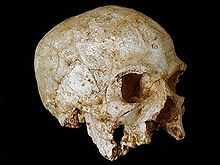Hofmeyr Skull
 | |
| Common name | Hofmeyr Skull |
|---|---|
| Species | Homo sapiens |
| Age | 37,000 years |
| Place discovered | South Africa Coordinates: 31°34′S 25°58′E / 31.567°S 25.967°E |
| Date discovered | 1952 |
The Hofmeyr Skull is a specimen of a 37,000 year old human skull found in 1952. It is one of the very few modern human skulls discovered in Africa south of Ethiopia and older than 20,000 years.
Background
The skull was found in the 1950s on the surface of an erosion gully,[1] a dry channel bed of the Vlekpoort River, near Hofmeyr,[2][3] a small town in Eastern Cape, South Africa. No other bones or archaeological artefacts were found in the vicinity at the time of the skull's discovery.[2] The skull is one of only a few African specimens of early modern humans dated over 30,000. Others are much more recent, dated to around 20,000 years ago.
In the 1990s, Alan Morris of the University of Cape Town noticed the skull in the Port Elizabeth Museum. He later showed it to Frederick E. Grine, an anthropologist and anatomist at State University of New York at Stony Brook. Grine then led a detailed study of the skull.[1]
Examination
It was not possible to date the skull using traditional radiocarbon dating, as the carbon had leached out of the bone. Instead, a new method involving a combination of optically stimulated luminescence and uranium-series dating methods was used. The method was developed by Richard Bailey of Oxford University. The earth material from the skull "filling the endocranial cavity" (central portion of the endocranial cavity) was dated using a combination of optically stimulated luminescence and uranium-series dating methods, coupled through a radiation-field model. Based on the assumption that the earth in the skull is about the age of its inhumation and thus the same as the age of the skull,[4] age was estimated to 36,200 ± 3,200 years old.[2]
The dating also assumed that the skull "had neither been uncovered long before nor transported any substantial distance before its discovery". The material in the skull can not have been washed out or replaced by water flowing down the gully because "the force required to scour the inner-most sediments would certainly have resulted in substantial damage" of the skull, and the skull did not appear to the dating team to have been damaged that much.[2]
The anterior part of the lower facial skeleton has been damaged. The angle of the mandible, the mastoid process of the right temporal, and much of the occipital are not present. The coronal suture is obliterated and the third molars are heavily worn, suggesting that the specimen reached adulthood. The skull's owner had been wounded over his left eye and the wound had partially healed before death. The most severe damage to the skull, however, was caused during its time in storage and "mishandling" after its 1950 discovery. A lost bone is documented on pictures from 1968 and 1998.[2]
Analysis
The Hofmeyr fossil was compared with skulls from Sub-Saharan Africa, including those of the KhoeSan, who are geographically close to the site of the find. Using 3-dimensional measurement and mapping techniques, the study found that the Hofmeyr Skull is rather distinct from those of recent Sub-Saharan Africans, and that its closest affinities were with the people who lived in Eurasia in the Upper Paleolithic period, at the same time as the Hofmeyr skull.
Alan Morris said that the skull's owner "would not look like modern Africans or like modern Europeans, or like modern Khoisan people, but he is definitely a modern human being".[1]
The skull demonstrates that humans in Africa 36,000 years ago resembled those in Eurasia. This evidence supports the recent single-origin hypothesis, which suggests that anatomically modern humans evolved in Africa before 200,000 to 100,000 years ago, with members of one branch leaving Africa between 65,000 and 25,000 years ago, spreading to the rest of the world and replacing other Homo species already there.[1]
See also
- List of fossil sites (with link directory)
- List of hominina (hominid) fossils (with images)
Footnotes
- ↑ 1.0 1.1 1.2 1.3 http://www.scienceinafrica.co.za/2007/february/fossil.htm
- ↑ 2.0 2.1 2.2 2.3 2.4 Grine, Fe; Bailey, Rm; Harvati, K; Nathan, Rp; Morris, Ag; Henderson, Gm; Ribot, I; Pike, Aw (Jan 2007). "Late Pleistocene human skull from Hofmeyr, South Africa, and modern human origins". Science 315 (5809): 226–9. Bibcode:2007Sci...315..226G. doi:10.1126/science.1136294. ISSN 0036-8075. PMID 17218524.
- ↑ The length of time between death and incorporation of the sediment within the skull is expected to be short: Grine 2007
Further reading
- F. E. Grine, FE; R. M. Bailey; K. Harvati; R. P. Nathan; A. G. Morris; G. M. Henderson; I. Ribot; A. W. G. Pike (12 January 2007). "Late Pleistocene Human Skull from Hofmeyr, South Africa, and Modern Human Origins". Science 315 (5809): 226–229. Bibcode:2007Sci...315..226G. doi:10.1126/science.1136294. PMID 17218524.
- Gosling, Melanie (12 January 2007). "Skull proves modern humans came from Africa". The Star. p. 12.
- Wilford, John Noble (11 January 2007). "Skull Provides Signs of When Humans Left Africa". The New York Times. Retrieved 2007-01-12.
- Markey, Sean (12 January 2007). "Skull Is First Fossil Proof of Human Migration Theory, Study Says". National Geographic.
- Gunz, FE; Gunz, P; Betti-Nash, L; Neubauer, S; Morris, AG et al. (2010). "Reconstruction of the late Pleistocene human skull from Hofmeyr, South Africa". Journal of Human Evolution (Elsevier) 59 (1): 1–15. doi:10.1016/j.jhevol.2010.02.007. PMID 20546848.